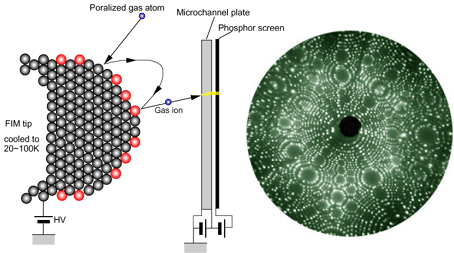field-ion microscope

A field-ion microscope is an instrument developed from its forerunner, the field-emission microscope, that enabled individual atoms to be imaged for the first time. The specimen takes the form of a sharp needle mounted on an electrically-insulated stage that is cooled to cryogenic temperatures (20 to 100K) in a ultrahigh vacuum chamber. The field ion image of the specimen is formed on a microchannel plate and phosphor screen assembly that is positioned approximately 50 millimeters in front of the specimen. To produce a field ion image, controlled amounts of image gas are admitted into the vacuum system. The type of image gas used depends on the material under investigation; common images gases are neon, helium, hydrogen and argon.
The image gas atoms in the vicinity of the specimen are polarized because of the high field and then attracted to the apex region of the specimen. After a series of collisions with the specimen during which the image gas atoms lose part of their kinetic energy, these image gas atoms become thermally accommodated to the cryogenic temperature of the specimen. If the field is sufficiently high, these image gas atoms are field ionized by a quantum-mechanical tunneling process. The ions produced are then radially repelled from the surface of the specimen towards the microchannel plate and screen assembly. A microchannel plate image intensifier positioned immediately in front of the phosphor screen produces between 103 and 104 electrons for each input ion. These electrons are accelerated towards the phosphor screen where they produce a visible image.
The field-ion microscope was invented by Erwin Müller in 1951 at Pennsylvania State University.


